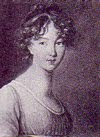 One of the biggest challenges in recreation of objects from the past is colour. Textiles from the past can be faded or have dyes which have unrecognisably changed. Paintings in good condition, and preferably seen in person, are an excellent source although the skeptic in me sometimes wonders about artistic license. Fabric companies in the United States, Britain and the Netherlands have, however, provided me with another source over the last ten years or so by reproducing lines based on quilts or other objects in excellent condition from the collections of major museums, supported by reliable research. I have made many reproduction quilts from the late 18th century through the 19th century using these lines, some of which are featured in the photograph which, unfortunately, appears here as a little cloudy or faded; the fabrics are much more vibrant in person. Of course, simply because a fabric was dyed with a specific blue or red does not always mean that one could have found wool, silk, cotton or linen in that shade but research about fabric, clothing, household and decorative arts objects, and the dyeing techniques (including longevity) related to them are always a good place to begin when I am planning a new project.
One of the biggest challenges in recreation of objects from the past is colour. Textiles from the past can be faded or have dyes which have unrecognisably changed. Paintings in good condition, and preferably seen in person, are an excellent source although the skeptic in me sometimes wonders about artistic license. Fabric companies in the United States, Britain and the Netherlands have, however, provided me with another source over the last ten years or so by reproducing lines based on quilts or other objects in excellent condition from the collections of major museums, supported by reliable research. I have made many reproduction quilts from the late 18th century through the 19th century using these lines, some of which are featured in the photograph which, unfortunately, appears here as a little cloudy or faded; the fabrics are much more vibrant in person. Of course, simply because a fabric was dyed with a specific blue or red does not always mean that one could have found wool, silk, cotton or linen in that shade but research about fabric, clothing, household and decorative arts objects, and the dyeing techniques (including longevity) related to them are always a good place to begin when I am planning a new project.
Gardens of colonial New Jersey
1 week ago


3 comments:
Hi! It's good to see that you're still blogging away. I've been so buried in catching up with own projects, blogging and otherwise, that it's been unconscionably long since I've stopped in. And here I get a lovely quilt for my troubles!
Forgive me if I've asked you this before, but what percentage of your decisions are based on fiction? If there is no reliable documentation pertaining to, say, color, then do you track down some novelist's throwaway comment about how everone in the room was struck by Henrietta's carmine ruffles?
Your question about fiction is a good one. I do use fiction as a source but it must be fiction written in the period as the same object that I am making, that is, contemporary to the object. Even then, I need to know, as in the case of Becky Sharp's green purse, which shades of green would be available then. Vanity Fair is a further good example as it was written about a time that was earlier than its publication date so I still had to investigate green purses from the second decade of the 19th century. The best written sources, in my opinion, are letters, journals, and contemporary magazines and fashion publications. Harder to get hold of but better for documentation.
What luscious colors, what luscious new and old patterns in your quilts, what exacting work too. I marvel at your output and shall look forward to The Garment being finished. I can imagine you hate to finish it, it looks like a very warm garment to work on in cold weather.
Hugh's question was very perceptive, it's a wonder that we can learn what colors and styles were used. Who of us ever writes about our new purse or pair of shoes in a truly descriptive way? Except, today I stumbled upon a purse forum! Women in love with their purses and shoes and proud of it. The Web shall be instant history of all sorts of details for later generations to research. (I was looking for something very mundane, how to repair very old Clarks' shoes with very slippery soles.)
Congratulations to you, History Knits for a very good blog.
~~ Linnea
Post a Comment